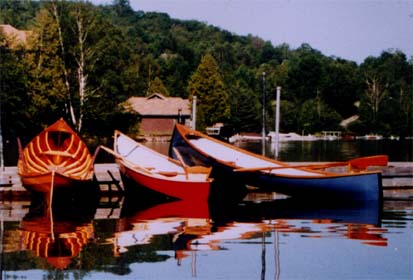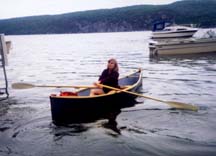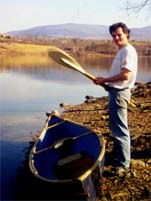
There is nothing—absolutely nothing—half so much worth doing as simply messing about in boats
Kenneth Grahame, The Wind in the Willows

There are many sublime pleasures in life, and while it is unfair to compare them, we all do (sex, for example, would appear at the top of a lot of lists). For me, one of the finest pleasures must be the absolute joy in motion that comes from putting all your energy and attention into some activity and having it flow, free and unobstructed. I remember having this feeling as a boy climbing trees or bicycling, or in those rare dreams in which I could fly like a bird, or sometimes dancing with abandon, and I suspect it’s the same feeling that runners, with enough training, know as the runner’s high. It is also the same feeling I had when I first took an Adirondack guide boat out on the water. In this case, however, it has nothing to do with my proficiency as a rower—I can count on my fingers the number of times I had been rowing before. Instead, it’s an indication of the elegance and perfect adaptation of the boat itself that the two of us—man clothed in boat—could somehow feel like a superbly fit athlete.
A rowboat doesn’t normally make us think of speed, of beauty, of sleekness. But the guide boat is not like a traditional rowboat. Or more correctly, the average rowboat, since the guide boat has a long tradition in Adirondack lakes, where it was often the only practical form of transportation, dating back to the 1830s. In overall shape, a guide boat is most reminiscent of a canoe, and many people (including me) have mistaken them for canoes at first sight. Once you see the oarlocks and lower seats the illusion is dispelled. The oars are part of the wonderful efficiency that makes the guide boat so much faster than a canoe. Comparisons may be unfair, but it’s hard to resist the competitive spirit. My daughter, her first time solo in any boat, proved faster in a guide boat crossing Lake Champlain that my wife and I, (both experienced) canoeing. In a canoe, of course, you waste a lot of energy just using the J-stroke to keep going in a straight line—a kayak would be a more fair comparison. So the speed of the guide boat was even more impressive when we easily outdistanced two college guys in a 2-person kayak—since my wife was rowing, I could simply relax and watch their reactions. In fairness, though, the speed and efficiency comes at some cost—it is the reach of the oars that turns muscle energy so directly into motion through the water, but that same reach makes it very difficult to maneuver at close quarters. Going down a narrow stream is much more fun in a canoe or kayak, and so is dodging rocks in fast-moving water. But on a lake or a river, the guide boat is a clear winner.
A small Vermont company, Adirondack Guide Boats, Inc., has been responsible for the renaissance of this elegant design. Located in Ferrisburgh, south of Burlington, they make beautiful wooden guide boats, lighter-weight kevlar ones, and a smaller model (kevlar only) called a packboat, light enough that one person can carry it strapped to a backpack. They also make kits for the wooden boats, and give workshops in building them. As appealing as it would be to build your own, it would require a labor of love, since even the professionals at the company take some 300 hours to complete one.
The cedar guide boat is clearly the most beautiful. At least one has been sold just as a work of art, not to put in the water. One on display in a Vermont visitor’s center met with the only unwelcome reception so far—"get that darn boat out of here, we’re sick of answering questions about it." Remarkably, the wooden boat is only about 10 lbs. heavier than the same-size kevlar boat (70 lbs. for cedar, 60 for kevlar). The only real problem with the cedar guide boat is the price, about $8,200. For about 20% of that, you can get the 12-foot kevlar packboat, which at 40 lbs. is a breeze for one person to heft onto a roofrack, or carry down to the dock. It will also carry two adults comfortably, but would be overloaded with 3, or with a load of camping gear.

The company’s founder is Steve Kaulback, an artist, designer, artisan, and authority on the guide boat. Trained as a fine artist and sculptor, Steve later studied boatbuilding, as well as learning, perhaps more than anyone else alive, about the Adirondack guide boat. He is the designer of all the company’s boats, for although the design is a classic one, there has been a steady evolution towards sleeker and faster, and at the same time more stable and more beautiful hulls. Steve’s business partner is Dave Rosen. Though they share a love of the boats and the water, in most other respects, Steve and Dave are polar opposites. Dave’s passion is not directed into being a craftsman or artist, but into growing a business, into organization, people, money, time, and of course into bringing in the right level of sales. Not too many orders, since the company has been making as many boats as they can for the last few years, and has never had the luxury of an inventory of product, ready to sell. Unless you get lucky, you’ll likely have to wait a few weeks for your boat to be built. Slowly building up the production side without compromising on quality is the responsibility of Randy, the production manager. Originally an aerospace engineer, Randy characterizes his job as going from raw materials in the door to beautiful finished boats out the door. In addition to these three, there are 8 to 10 more people working on the boats, building, tuning and tweaking, sanding, spreading epoxy, varnishing.

Inevitably, the different contributions and passions of Steve, Dave and Randy lead to a dynamic tension, and their competing ideals mean the relationship is not always an easy one. But the result of that creative conflict is a finer product than could emerge from any single vision. I remember an interview with the Grateful Dead in which Jerry Garcia recalled an incredibly frustrating recording session in which Jerry and Phil Lesh were constantly pulling the music in different directions. They were fuming when the session was over, but later, listening to them, discovered the tapes were the best they’d done, "crackling with energy." This is what the Adirondack guide boats are, a wonderful synthesis born from opposing pulls—speed vs. stability, maneuverability vs. efficiency, beauty vs. utility. It’s no wonder that when you row in one, you can feel such a sense of absolute peace at the same time as masterful power and speed. The combination is addictive—if only a lake in the backyard were as easy to procure as a packboat.
You can visit Adirondack Guide Boats at their factory on Route 7 in Ferrisburgh, Vermont, (802) 425-3926, or visit their website at www.adirondack-guide-boat.com.
David Pearson works as a computer scientist and software engineer, which gives him a keen appreciation for the outdoors. He is also co-editor and general computer troubleshooter for Planet Vermont Quarterly
Cover
Other issues
Editorial mission
Information for advertisers
Links
Directory
Calendar
Submission guidelines
Suggestions? Send us email